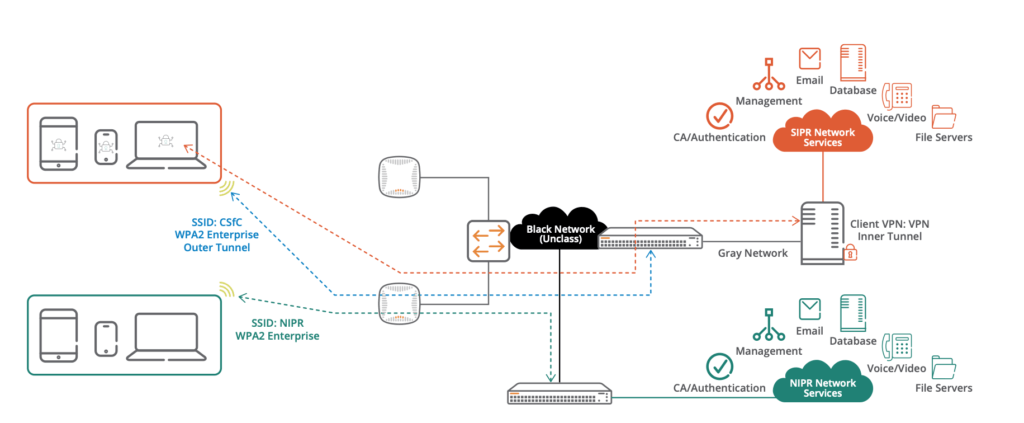
As COVID-19 restrictions are reduced, government employees are readying for a return to the office. A study of Federal workers taken in September 2020 revealed that more than half expect to return to their offices in six months or more.
Before everyone is back at their desks, you can make a simple networking change that leads to big rewards. Upgrading your Aruba Mobility Controllers to run ArubaOS 8 can improve network user experiences, streamline daily network admin tasks, and simplify network engineering.
1. Agencies will experience no downtime when upgrading to ArubaOS 8. Scheduling network downtime for maintenance is never easy. ArubaOS 8 includes Live Upgrade so you can upgrade the wireless network operating system on Mobility Controllers, Mobility Conductors and controller-managed APs without interruption.
Live Upgrade combines Controller Clustering and AirMatch to ensure that the network is always on. The system is updated in waves, starting with one controller and moving the APs to other controllers. For years now, Aruba commercial customers have completed upgrades, even during the workday, with no impact on user connectivity and productivity.
2. Mobile user experiences are better than ever. AirMatch, another feature in ArubaOS 8, applies automation and intelligence to give wireless users a consistent, reliable experience. If a public meeting room that usually hosts 200 people becomes filled with 800 constituents due to a highly visible item on the agenda, AirMatch can dynamically adjust the channel bandwidth to reduce congestion to optimize the Wi-Fi experience. Or, if an AP goes down during the meeting, other APs will adjust their power level to fill that dead zone.
3. An intuitive UI streamlines admin tasks. The ArubaOS 8 UI and workflow is intuitive and easy to use. This demo video shows how simple it is to create a new network and set policies.
4. Support multiple data classifications on the same set of APs. IT can use MultiZone AP, a feature in ArubaOS 8, to create separate segments to allow multiple data classifications to share the same set of APs. Sensitive unclassified network traffic can be separated from classified network traffic, while leveraging the same physical APs and RF environment. MultiZone eliminates the need to buy and deploy a different set of APs to support different classification levels, increasing operational efficiency.
Different government agencies operating in the same facility can share a common network infrastructure. Visitors and contractors can have Wi-Fi access to their own resources, with the appropriate levels of control, but leveraging a shared physical infrastructure.
Additionally, the accessibility, configuration, and monitoring of the separate user environments can be delegated to the appropriate IT staff.

With Aruba MultiZone, additional zones can be implemented (for example, an unclassified network) where a VPN solution won't be required. Unclassified traffic will be directed away from the CSfC controller toward a “Data Zone” unclassified controller.
5. Reduce security gaps and protect the network from insecure IoT devices. Cybercriminals have been incredibly active during the pandemic, and unpatched software or legacy software creates security risks. By migrating to AOS 8, your network is protected against the latest threats.
ArubaOS 8 also addresses the influx of IoT devices that typically have weak security. IT can leverage included features such as MultiZone, Policy Enforcement Firewall, Role Based Access, and Dynamic Segmentation in conjunction with Aruba’s ClearPass Policy Manager to isolate IoT device traffic from organizational traffic.
6. Better application visibility and control for thousands of apps. Apps run the world, and Policy Enforcement Firewall, an ArubaOS license, enables visibility into more than 3,000 apps and their users. IT can enforce policies based on user role, application, device, and location awareness, and Policy Enforcement Firewall applies Deep Packet Inspection for traffic classification. Network admins can limit traffic per application so that mission-critical apps continue to perform when needed.
7. ArubaOS 8 establishes a clear, trouble-free path to IPv6. The transition to IPv6 is underway within many government agencies, as wireless has become mission critical and networks need the vast IP addressing space of IPv6. Within every agency, IT must decide if the path to IPv6 will be a dual stack environment that supports IPv4 and IPv6 or a full deployment of IPv6. ArubaOS 8 supports both these decisions, handling the deployment, management, and monitoring of Mobility Controllers and APs in both IPv6 and dual-stack environments.
See ArubaOS 8 in Action
The great news is that ArubaOS 8 is a mature, field-proven operating system that’s Common Criteria certified and FIPS validated and available on the DoDIN APL. Migrate to Aruba OS 8 to enable greater organizational agility and streamlined operations.
Your Aruba Federal Sales teams are available to dive deeper into the value AOS 8 brings to your WLAN networks and assist with a migration plan. Aruba also offers Professional Services to expedite your agency’s move to AOS 8.




